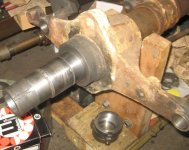99Panhard
Stainless
- Joined
- Feb 22, 2006
- Location
- Smithfield, Rhode Island
This the the full-floating rear axle from my 1910 Mitchell. The portion at the rear held the original bearing...one of those "balls in a cage" bicycle bearings. Not only were they not very good but in this case both of the cups that are pressed into the hub are broken. My goal is to fit new bearings but I've come up against a problem. The diameter of the bearing seat is 2.503, about .003 larger than 2.5". The original rear bearing race measures 2.502 or thereabout in as much as I'm able to tell with my telescoping gauges. I've read over the threads here on using those and I have been able to get a repeatable measurement but in all cases it is slightly larger than 2.5".
I'd like to use the bearings below...but, being modern the ID is a real 2.5". My question is...does anyone have an idea how I can reduce the OD of the bearing seat by .002? I was thinking of making a fixture to hold a piece of abrasive material - maybe 120 grit - that would clamp onto the seat and could be tightened gradually. It would work but might take a long time to remove that much material... So I thought I'd ask the experts before doing anything.
The pictures are the rear spindle...the original rear bearing race and the new bearing.


I'd like to use the bearings below...but, being modern the ID is a real 2.5". My question is...does anyone have an idea how I can reduce the OD of the bearing seat by .002? I was thinking of making a fixture to hold a piece of abrasive material - maybe 120 grit - that would clamp onto the seat and could be tightened gradually. It would work but might take a long time to remove that much material... So I thought I'd ask the experts before doing anything.
The pictures are the rear spindle...the original rear bearing race and the new bearing.





